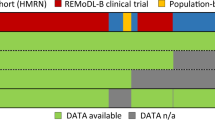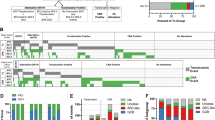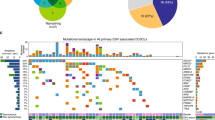Abstract
Recurrences of diffuse large B-cell lymphomas (DLBCL) result in significant morbidity and mortality, but their underlying genetic and biological mechanisms are unclear. Clonal relationship in DLBCL relapses so far is mostly addressed by the investigation of immunoglobulin (IG) rearrangements, therefore, lacking deeper insights into genome-wide lymphoma evolution. We studied mutations and copy number aberrations in 20 paired relapsing and 20 non-relapsing DLBCL cases aiming to test the clonal relationship between primaries and relapses to track tumors’ genetic evolution and to investigate the genetic background of DLBCL recurrence. Three clonally unrelated DLBCL relapses were identified (15%). Also, two distinct patterns of genetic evolution in clonally related relapses were detected as follows: (1) early-divergent/branching evolution from a common progenitor in 6 patients (30%), and (2) late-divergent/linear progression of relapses in 11 patients (65%). Analysis of recurrent genetic events identified potential early drivers of lymphomagenesis (KMT2D, MYD88, CD79B and PIM1). The most frequent relapse-specific events were additional mutations in KMT2D and alterations of MEF2B. SOCS1 mutations were exclusive to non-relapsing DLBCL, whereas primaries of relapsing DLBCL more commonly displayed gains of 10p15.3–p12.1 containing the potential oncogenes PRKCQ, GATA3, MLLT10 and ABI1. Altogether, our study expands the knowledge on clonal relationship, genetic evolution and mutational basis of DLBCL relapses.
This is a preview of subscription content, access via your institution
Access options
Subscribe to this journal
Receive 12 print issues and online access
$259.00 per year
only $21.58 per issue
Buy this article
- Purchase on Springer Link
- Instant access to full article PDF
Prices may be subject to local taxes which are calculated during checkout






Similar content being viewed by others
References
Friedberg JW . Relapsed/refractory diffuse large B-cell lymphoma. Hematology Am Soc Hematol Educ Program 2011; 2011: 498–505.
Philip T, Guglielmi C, Hagenbeek A, Somers R, Van der Lelie H, Bron D et al. Autologous bone marrow transplantation as compared with salvage chemotherapy in relapses of chemotherapy-sensitive non-Hodgkin’s lymphoma. N Engl J Med 1995; 333: 1540–1545.
Gisselbrecht C, Glass B, Mounier N, Singh Gill D, Linch DC, Trneny M et al. Salvage regimens with autologous transplantation for relapsed large B-cell lymphoma in the rituximab era. J Clin Oncol 2010; 28: 4184–4190.
de Jong D, Glas AM, Boerrigter L, Hermus M-C, Dalesio O, Willemse E et al. Very late relapse in diffuse large B-cell lymphoma represents clonally related disease and is marked by germinal center cell features. Blood 2003; 102: 324–327.
Geurts-Giele WRR, Wolvers-Tettero ILM, Dinjens WNM, Lam KH, Langerak AW . Successive B-cell lymphomas mostly reflect recurrences rather than unrelated primary lymphomas. Am J Clin Pathol 2013; 140: 114–126.
Shioyama Y, Nakamura K, Kunitake N, Kimura M, Terashima H, Masuda K . Relapsed non-Hodgkin’s lymphoma: detection and treatment. Radiat Med 2000; 18: 369–375.
Libra M, De Re V, Gloghini A, Navolanic PM, Carbone A, Boiocchi M . Second primary lymphoma or recurrence: a dilemma solved by VDJ rearrangement analysis. Leuk Lymphoma 2004; 45: 1539–1543.
Nishiuchi R, Yoshino T, Teramoto N, Sakuma I, Hayashi K, Nakamura S et al. Clonal analysis by polymerase chain reaction of B-cell lymphoma with late relapse: a report of five cases. Cancer 1996; 77: 757–762.
Obermann EC, Mueller N, Rufle A, Menter T, Mueller-Garamvoelgyi E, Cathomas G et al. Clonal relationship of classical hodgkin lymphoma and its recurrences. Clin Cancer Res 2011; 17: 5268–5274.
Siddiqi IN, Ailawadhi S, Huang Q, Shibata RK, Kang H, Shibata D . Deep sequencing reveals lack of a clonal relationship between a metachronous classical hodgkin and diffuse large B-cell lymphoma. Clin Lymphoma Myeloma Leuk 2014; 14: e87–e93.
Cobb RM, Oestreich KJ, Osipovich OA, Oltz EM . Accessibility control of V(D)J recombination. Adv Immunol 2006; 91: 45–109.
Jiang Y, Redmond D, Nie K, Eng KW, Clozel T, Martin P et al. Deep-sequencing reveals clonal evolution patterns and mutation events associated with relapse in B-cell lymphomas. Genome Biol 2014; 15: 432.
Torres L, Ribeiro FR, Pandis N, Andersen JA, Heim S, Teixeira MR . Intratumor genomic heterogeneity in breast cancer with clonal divergence between primary carcinomas and lymph node metastases. Breast Cancer Res Treat 2007; 102: 143–155.
Ostrovnaya I, Olshen AB, Seshan VE, Orlow I, Albertson DG, Begg CB . A metastasis or a second independent cancer? Evaluating the clonal origin of tumors using array copy number data. Stat Med 2010; 29: 1608–1621.
Mareschal S, Dubois S, Viailly P-J, Bertrand P, Bohers E, Maingonnat C et al. Whole exome sequencing of relapsed/refractory patients expands the repertoire of somatic mutations in diffuse large B-cell lymphoma. Genes Chromosomes Cancer 2015; 55: 251–267.
Morin RD, Assouline SE, Alcaide M, Mohajeri A, Johnston RL, Chong L et al. Genetic landscapes of relapsed and refractory diffuse large B cell lymphomas. Clin Cancer Res 2015; 22: 2290–2300.
Nagel S, Hirschmann P, Dirnhofer S, Günthert U, Tzankov A . Coexpression of CD44 variant isoforms and receptor for hyaluronic acid-mediated motility (RHAMM, CD168) is an International Prognostic Index and C-MYC gene status-independent predictor of poor outcome in diffuse large B-cell lymphomas. Exp Hematol 2010; 38: 38–45.
Meier VS, Rufle A, Gudat F . Simultaneous evaluation of T- and B-cell clonality, t(11;14) and t(14;18), in a single reaction by a four-color multiplex polymerase chain reaction assay and automated high-resolution fragment analysis: a method for the rapid molecular diagnosis of lympho. Am J Pathol 2001; 159: 2031–2043.
Ye J, Ma N, Madden TL, Ostell JM . IgBLAST: an immunoglobulin variable domain sequence analysis tool. Nucleic Acids Res 2013; 41: W34–W40.
Juskevicius D, Ruiz C, Dirnhofer S, Tzankov A . Clinical, morphologic, phenotypic, and genetic evidence of cyclin D1-positive diffuse large B-cell lymphomas with CYCLIN D1 gene rearrangements. Am J Surg Pathol 2014; 38: 719–727.
Lipson D, Aumann Y, Ben-Dor A, Linial N, Yakhini Z . Efficient calculation of interval scores for DNA copy number data analysis. J Comput Biol 2006; 13: 215–228.
Visco C, Tzankov A, Xu-Monette ZY, Miranda RN, Tai YC, Li Y et al. Patients with diffuse large B-cell lymphoma of germinal center origin with BCL2 translocations have poor outcome, irrespective of MYC status: a report from an International DLBCL rituximab-CHOP Consortium Program Study. Haematologica 2013; 98: 255–263.
Mao Z, Quintanilla-Martinez L, Raffeld M, Richter M, Krugmann J, Burek C et al. IgVH mutational status and clonality analysis of Richter’s transformation: diffuse large B-cell lymphoma and Hodgkin lymphoma in association with B-cell chronic lymphocytic leukemia (B-CLL) represent 2 different pathways of disease evolution. Am J Surg Pathol 2007; 31: 1605–1614.
Ganzel C, Pogrebijsky G, Krichevsky S, Neuman T, Yehuda D Ben . Separate diagnoses of Hodgkin lymphoma and non-Hodgkin lymphoma in an individual patient might not signify a common clonal origin. Exp Hematol 2012; 40: 698–704.
Libra M, De Re V, Gasparotto D, Gloghini A, Marzotto A, Milan I et al. Differentiation between non-Hodgkin’s lymphoma recurrence and second primary lymphoma by VDJ rearrangement analysis. Br J Haematol 2002; 118: 809–812.
Lossos A, Ashhab Y, Sverdlin E, Amir G, Ben-Yehuda D, Siegal T . Late-delayed cerebral involvement in systemic non-hodgkin lymphoma: A second primary tumor or a tardy recurrence? Cancer 2004; 101: 1843–1849.
Wa CV, DeVries S, Chen YY, Waldman FM, Hwang ES . Clinical application of array-based comparative genomic hybridization to define the relationship between multiple synchronous tumors. Mod Pathol 2005; 18: 591–597.
Waldman FM, DeVries S, Chew KL, Moore DH, Kerlikowske K, Ljung BM . Chromosomal alterations in ductal carcinomas in situ and their in situ recurrences. J Natl Cancer Inst 2000; 92: 313–320.
Steensma DP, Bejar R, Jaiswal S, Lindsley RC, Sekeres MA, Hasserjian RP et al. Clonal hematopoiesis of indeterminate potential and its distinction from myelodysplastic syndromes. Blood 2015; 126: 9–16.
Läubli H, Tzankov A, Juskevicius D, Degen L, Rochlitz C, Stenner-Liewen F . Lenalidomide monotherapy leads to a complete remission in refractory B-cell post-transplant lymphoproliferative disorder. Leuk Lymphoma 2016; 57: 945–948.
Pasqualucci L, Khiabanian H, Fangazio M, Vasishtha M, Messina M, Holmes AB et al. Genetics of follicular lymphoma transformation. Cell Rep 2014; 6: 130–140.
Okosun J, Bödör C, Wang J, Araf S, Yang C-Y, Pan C et al. Integrated genomic analysis identifies recurrent mutations and evolution patterns driving the initiation and progression of follicular lymphoma. Nat Genet 2014; 46: 176–181.
Asić K . Dominant mechanisms of primary resistance differ from dominant mechanisms of secondary resistance to targeted therapies. Crit Rev Oncol Hematol 2016; 97: 178–196.
Futreal PA, Coin L, Marshall M, Down T, Hubbard T, Wooster R et al. A census of human cancer genes. Nat Rev Cancer 2004; 4: 177–183.
Felli MP, Vacca A, Calce A, Bellavia D, Campese AF, Grillo R et al. PKC theta mediates pre-TCR signaling and contributes to Notch3-induced T-cell leukemia. Oncogene 2005; 24: 992–1000.
Briones J, Moga E, Espinosa I, Vergara C, Alvarez E, Villa J et al. Bcl-10 protein highly correlates with the expression of phosphorylated p65 NF-kappaB in peripheral T-cell lymphomas and is associated with clinical outcome. Histopathology 2009; 54: 478–485.
Schif B, Lennerz JK, Kohler CW, Kreuz M, Bentink S, Melzner I et al. SOCS1 mutation subtypes predict divergent outcomes in diffuse large B-cell lymphoma (DLBCL) patients. Oncotarget 2012; 4: 35–47.
Acknowledgements
This study was supported by Krebsliga beider Basel and Stiftung zur Krebsbekämpfung Zürich. We thank Sibylle Tschumi, Tanja Dietsche, David Jucker, Luca Quagliata and Bruno Grilli for their help in performing NGS and FISH investigations. The chromosomal copy number aberration data reported in this paper has been deposited at the National Center for Biotechnology Information Gene Expression Omnibus (accession no. GSE65720). The targeted sequencing data has been deposited to Sequence Read Archive (accession no. SRP067323).
Author contributions
DJ performed the research, analyzed and interpreted the data, and wrote the manuscript; JG, CR and TL analyzed the data and revised the manuscript; VP contributed to sequencing analysis; FS-L analyzed the clinical data and revised the manuscript; SD performed histological and immunohistochemical analysis, revised the manuscript; AT conceived and designed the study, performed histological, immunohistochemical and FISH analysis, analyzed and interpreted the data, and revised the manuscript.
Author information
Authors and Affiliations
Corresponding author
Ethics declarations
Competing interests
The authors declare no conflict of interest.
Additional information
Supplementary Information accompanies this paper on the Leukemia website
Rights and permissions
About this article
Cite this article
Juskevicius, D., Lorber, T., Gsponer, J. et al. Distinct genetic evolution patterns of relapsing diffuse large B-cell lymphoma revealed by genome-wide copy number aberration and targeted sequencing analysis. Leukemia 30, 2385–2395 (2016). https://doi.org/10.1038/leu.2016.135
Received:
Revised:
Accepted:
Published:
Issue Date:
DOI: https://doi.org/10.1038/leu.2016.135
This article is cited by
-
Clinical significance of plasma PD-L1+ exosomes in the management of diffuse large B cell lymphoma
Annals of Hematology (2023)
-
Potential role of the P2X7 receptor in the proliferation of human diffused large B-cell lymphoma
Purinergic Signalling (2023)
-
Next-generation sequencing for MRD monitoring in B-lineage malignancies: from bench to bedside
Experimental Hematology & Oncology (2022)
-
Qin Huang formula enhances the effect of Adriamycin in B-cell lymphoma via increasing tumor infiltrating lymphocytes by targeting toll-like receptor signaling pathway
BMC Complementary Medicine and Therapies (2022)
-
Mutational landscape of marginal zone B-cell lymphomas of various origin: organotypic alterations and diagnostic potential for assignment of organ origin
Virchows Archiv (2022)



